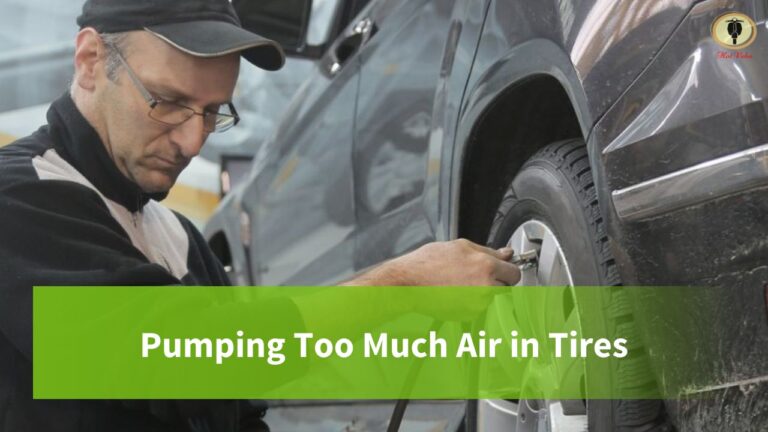Following the manufacturer’s recommended tire pressure is critical. It will ensure that the tire delivers the promised performance and promotes long mileage and enhanced safety.
Overinflation of tires can cause multiple potential issues, including increased blowout chance or accidents and premature or uneven tread wear. But, how much air pressure is too much? What will happen if your tire has too much air? Is it safe to overinflate tires?
Pumping Too Much Air in Tires
These are the questions I hope to answer, so read on and enjoy.
Symptoms of Tire Overinflation
The key indicators that your tire is overinflated include lack of traction, excessive center tread wear, and uncomfortable ride.
Lack of Traction
Traction is what gets your vehicle moving by transferring the engine’s energy to the pavement. If you don’t have reliable traction, it results in poor mileage.
When you overinflate your tires, you compromise traction because the road contact patch is not optimized. The center portion of the tire is where the contact is mostly happening. Therefore, the tire can hardly deliver excellent traction.
Excessive Center Tread Wear
As you learned above, if the tire is overinflated, the part of it that touches the road is the center. Thus, it is the first to wear out due to road friction.
Uncomfortable Ride
I am sure you know what an uncomfortable ride is. You either quickly lose control of your vehicle, or your car vibrates a lot. I drive a manual car, and it is a bit old. In saying so, it does not have a tire pressure monitoring system (TPMS). I can share that I have experienced this a lot.
When your tire is overinflated, you feel a solid vibration when you drive on a rough or bumpy road. You can’t help but notice it. It is happening because the tire is stiff and cannot adjust to the uneven surface.
Can Too Much Air in Tires Cause Car Shakes?
When your vehicle shakes, it is more likely a case of underinflation; your tires probably lack air pressure. You do not usually experience shaking in the case of overinflation.
An overinflated tire is like a ball that bounces, so you would likely feel vibration rather than shaking.
Can Too Much Air in Tires Cause Vibration?
We’ve talked about the vehicle not experiencing much shaking movement when you overinflate your tires. However, it will surely give your ride some vibrations.
When you drive on an uneven road surface or a rough road, there is no doubt that you will feel rapid vibration due to the tire’s stiffness. However, because the tire is full of air, it can hardly absorb the road vibration, passing it to the vehicle, driver, and passengers.
How Dangerous Can Too Much Air in Tires Be?
The worse thing that could happen when you overinflate your tires is a blowout incident. When your tire blows out, you and your passengers are put in danger because it can substantially cause accidents.
As pointed out at the beginning of this article, traction is compromised when your tires are overinflated. Is this dangerous? It is! Yes, it is! Why? With poor traction, your vehicle may not stop as you wanted it, causing a horrifying accident.
If you put too much air in your tires, they also become prone to damage from road hazards such as potholes, curbs, and cracks. When your tire is damaged, a lot of ugly things could happen. But, on the other hand, you can have a flat tire in the middle of nowhere.
Can a Tire Explode from Too Much Air?
As you have been reading above, an overinflated tire may explode. Technically, tires can explode if you load up to 200 psi of air pressure. But I am 100% sure you are not doing that. I don’t think a crazy car owner would attempt to do that.
However, even if you do not put that much air pressure in your tires, the pressure level increases as the tires hit a bump, pothole, or curd. Therefore, depending on the impact level, the chance of a blowout is high when your tires are overinflated.
The quality of the tires you mount on your vehicle also matters. Tires made of low-quality materials may have lower resistance to high air pressure. These tires can quickly explode if the air pressure exceeds what it can handle.
How to Remove Too Much Air in Tire
If you are aware that your tire is overinflated, below are the simple steps you can follow:
Step 1 – Locate the valve stem. Go to the overinflated tire and find the valve stem. The valve stem is the small tube that protrudes from the tire where you pump the air.
Step 2 – Unscrew the valve stem cap. Most valve stems have a cap that protects them from damage by road chemicals. Remove the cap to start the process of reducing the tire air pressure.
Step 3 – Check the pressure level. You can use a pressure gauge to do this.
Stem – 4 – Reduce the air pressure level. It is a simple step of pushing the metal pin of the valve stem with the back end of the air gauge. Check the remaining air pressure regularly so as not to underinflate your tire. Stop the process when you have obtained the ideal pressure.
Step 5 – Put the valve step cap back. Next, put the cap of the valve stem pack in place. Ensure not to forget this to avoid exposing this tire component, leading to untimely wear out or damage.
How to Check Tire Pressure without a Gauge
What if you don’t have an air pressure gauge? Is it possible to check your car tire’s pressure? Yes, it is possible.
There are a few methods that you can consider. They may seem difficult at first, but once you learn them, they might be helpful. I will mention some of the methods below.
Hand Pressure Method
You can push your hand down onto the tire and feel the pressure. If the tire is soft, it needs more pressure. If it is rock hard, you need to release some air. Obtain a softness level where you can slightly push down into the tire – not too soft, not too hard.
Eyeball Method
Not many drivers know how to use this method as it takes more time and experience to learn. You need to park your car on an even surface to do this. Then, you need to look at the front and the back of the vehicle from a distance. Ensure that no part of the tire is protruding.
Mud Ride Method
This method can be amusing. You can ride your car in the mud (literally) then observe the tire mark on flat pavement. The marks on the road will tell you how much of the tire is touching the road. A properly inflated tire’s road mark should show that the complete tread area of the tire touches the road surface.
You can also use a marking substance or ink for this method by applying it to your tires. Then, you can repeat checking the road mark until you achieve the desired. Again, all of the tread areas of the tire should touch the road surface.
What is the Ideal Tire Pressure?
You probably wonder what the ideal tire pressure is. The newer cars model now includes a sticker with the recommended tire pressure. If you do not find a sticker listing the ideal tire pressure, it should be in the vehicle’s manual.
Generally, the recommended air pressure for most passenger cars ranges from 32 to 35 psi.
In my case, I have a “go-to” mechanic who checks my tire pressure every couple of weeks. There is no doubt that we can estimate the air pressure we load into our tires. However, getting it done correctly with the proper tools is always ideal.
Economic Impact of Overinflating Tires
You need to understand that pumping too much air into your tire also has some economic impact. Overinflated tires do not wear evenly. Thus, your tire’s life may become shorter, which means you will need to replace your tires earlier.
Because overinflated tires are prone to damage and explosion, it puts you in an uncertain situation. Of course, you cannot predict when an incident will happen, but one thing is sure, it will be an unexpected expense for you.
As you learned above, overinflated tires do not have a good patch with the road. Thus, traction is compromised. As a result, your vehicle’s mileage is not efficient. In addition, you will be burning more gas than driving a car with properly inflated tires.
Conclusion
Pumping too much air in your tires is not good. It can give you multiple issues like unstable handling, less traction, and uncomfortable ride due to vibration.
Overinflating your tires can also potentially cause them to blow out. Therefore, pumping too much air in our tires compromises your safety.
Overinflated tires are also prone to damage caused by road hazards and conditions such as potholes, bumps, and curbs.

